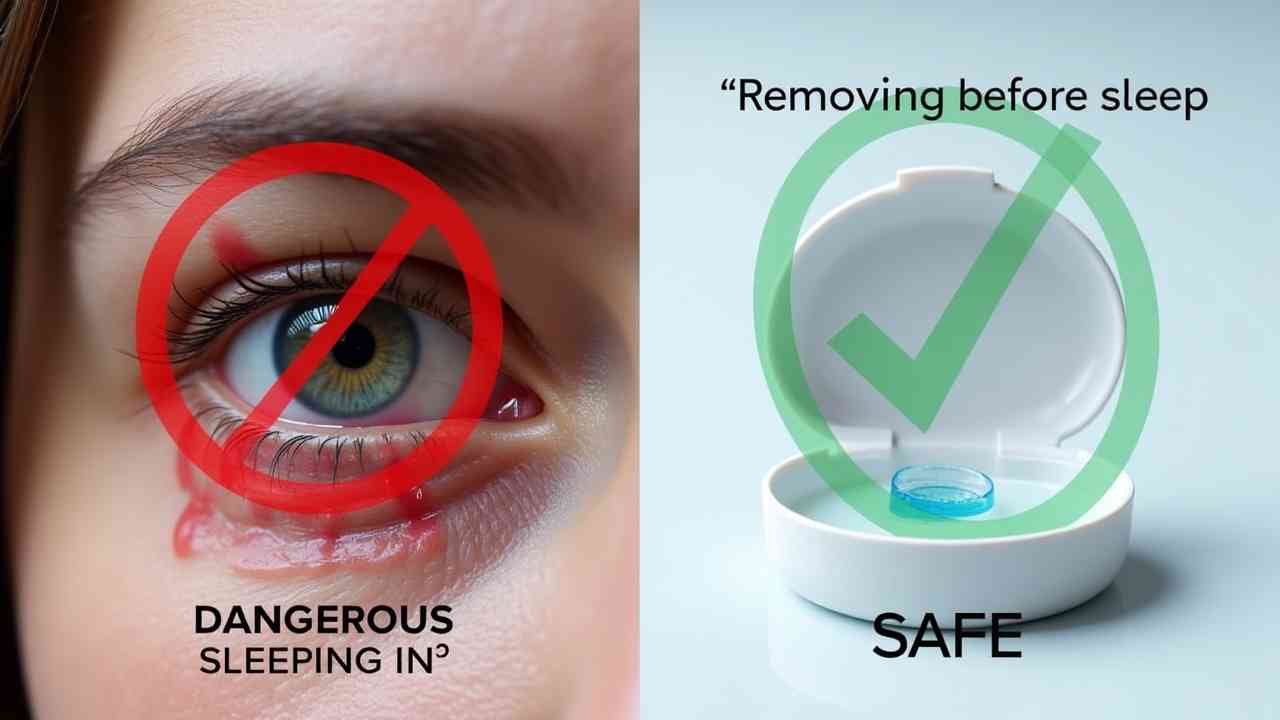
👁️ What Happens If You Sleep with Contacts? An Eye Doctor's Warning
👁️ A Doctor's Warning: Why You Should Never Sleep in Your Contacts 👁️
❗ CRITICAL HEALTH AND SAFETY WARNING: Sleeping in contact lenses, even those approved for "extended wear," dramatically increases your risk of serious, vision-threatening eye infections. This guide is a health warning about the significant dangers. If you experience eye pain, redness, or blurry vision after sleeping in your contacts, see an eye doctor immediately.
It is the end of a long day, and you are exhausted. The thought of getting up to take out your contact lenses feels like a monumental effort. It is a tempting shortcut that millions of people take. However, it is also one of the single riskiest things you can do for your eye health.
So, what happens if you sleep with your contacts in? This simple act of negligence creates a perfect storm for damaging your eyes. This guide will explain the science behind the risks. Let's get clear on this crucial safety rule. ✅
🤔 First, Why Is It So Dangerous? (The Oxygen Problem)
The main reason it is so dangerous is simple: oxygen. Your cornea, the clear front part of your eye, is a living tissue that needs a constant supply of oxygen to stay healthy. Unlike other parts of your body, the cornea gets its oxygen directly from the air, not from blood vessels.
A contact lens is a piece of plastic that sits directly on your cornea, acting as a barrier. Even the most breathable modern lenses reduce the amount of oxygen that reaches your eye. When you close your eyes to sleep, you are putting another barrier (your eyelid) over the lens. This combination severely deprives your cornea of the oxygen it needs to survive, a condition called corneal hypoxia.
- What Are the Severe Risks of Sleeping in Contacts?
An oxygen-starved cornea is a weak cornea. It becomes vulnerable to a host of serious and painful problems.
1. What is a Corneal Ulcer (Microbial Keratitis)?
This is the most serious and sight-threatening risk. The lack of oxygen can cause the surface cells of your cornea to break down, creating microscopic tears. Bacteria, which are naturally present on your eyelids and can get trapped under the lens, see this as an open door. They can cause a severe infection, leading to an open sore on your cornea called an ulcer. A corneal ulcer is a medical emergency that is incredibly painful and can lead to permanent scarring and vision loss.
2. What other complications can occur?
- Severe Redness and Pain: The lack of oxygen causes inflammation and irritation.
- Corneal Neovascularization: In a desperate attempt to get oxygen, your eye can start to grow new, fragile blood vessels onto the clear cornea. This can interfere with your vision and make it impossible to wear contact lenses in the future.
- Giant Papillary Conjunctivitis (GPC): Bumps can form under your eyelid, making lens wear very uncomfortable.
- What About 'Extended Wear' Lenses?
Some contact lenses are FDA-approved for overnight or extended wear. While these are made from more breathable materials, it is crucial to understand that they still carry a significantly higher risk of infection compared to daily-wear lenses. Most eye doctors still recommend against sleeping in them if it can be avoided. They are not a risk-free option.
- What Should You Do If You Accidentally Fall Asleep in Them?
- Don't Panic: Don't try to rip the lens out immediately, as it may be dry and stuck to your eye.
- Re-hydrate: Use sterile saline solution or rewetting drops to lubricate your eye. Blink several times.
- Remove Gently: Once the lens is moving freely, remove it gently.
- Give Your Eyes a Break: Wear your glasses for at least the next full day to allow your corneas to recover.
- Monitor for Symptoms: If you experience any persistent pain, redness, light sensitivity, or blurry vision, see your eye doctor immediately.
Taking two minutes to remove your contacts at night is a simple habit that can save your vision for a lifetime. ✨